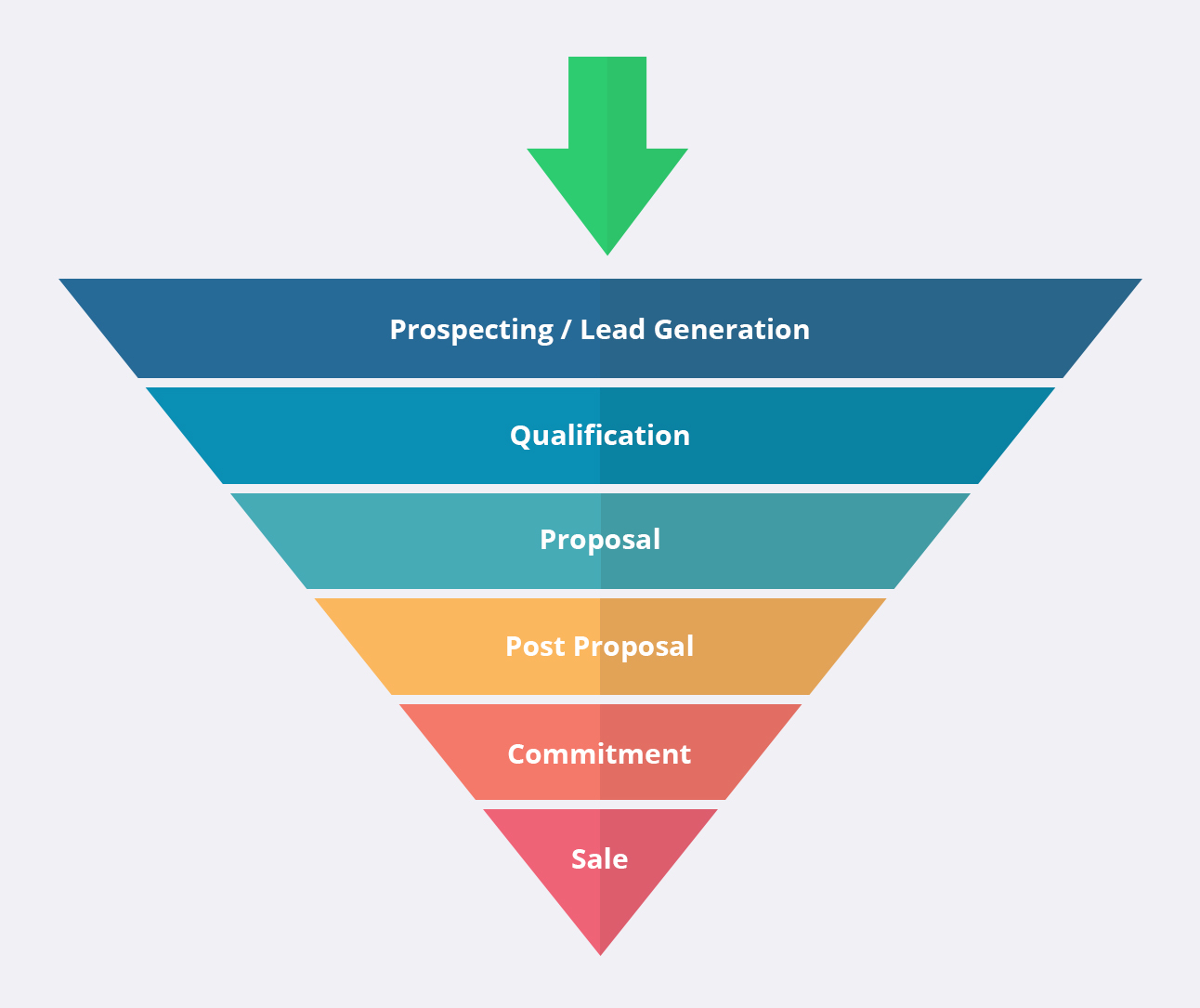Pipeline marketing has become the benchmark approach marketers utilize to generate revenue. It is a major step forward from the traditional lead generation approach, which focuses on capturing information and hoping that the maximum number of leads convert.
In a pipeline marketing campaign, leads are nurtured through timely and personalized messages driven by data to turn the lead into a customer. As such, campaigns incur a higher cost than classic automated marketing initiatives and thus need to be perfect.
This marketing approach places marketing and sales under one roof. With pipeline marketing, revenue is the measure of success. Not leads generated, nor goal conversions rates. Just cold hard sales.
The Sales Pipeline
The sales pipeline is divided into three major parts, being:
- top of funnel
- middle of funnel
- bottom of funnel.
Here leads are moved through 5 marketing pipeline stages before finally becoming a paying customer.

Top of funnel
This stage of the sales funnel is identical to the entirety of traditional lead generation marketing. Here your focus is on reaching out to as many people as possible and capturing their information. Thus, turning them into leads.
You can do a few things to capture leads, including setting up lead magnets on your website, asking visitors to subscribe after visiting your blog, cold calling and reaching out to social media followers.
Your goal should be to capture as much information as possible, so that you can later tailor your messages based on your lead’s profile. Following lead generation, you will move straight to the middle of the funnel you nurture leads to convert them to customers.
Middle of funnel
Whether you’re nurturing leads through content marketing such as email drip campaigns or targeted social media ads, your marketing pipeline strategy should not rely on automation. All messages should be tailored to each lead. During this stage of the funnel, leads become marketing and then sales qualified.
During the middle of the sales and marketing pipeline, you can nurture leads by offering them more information such as previews of your product, extending invites to a free webinar and sending case studies of past work to inspire confidence.
Whatever method you choose, it’s important to remember that content is still king. The messages you send need to resonate with your potential buyers.
Bottom of funnel
This is where all the revenue generation happens; where leads hand over their hard earned cash and become customers. Unfortunately, this is where many online businesses fall short, deciding to focus on generating leads instead of generating revenue.
The bottom of the sales pipeline is not just about making sales, it’s also an opportunity to gain customer loyalty. To do this, you can offer discounts on future purchases or any other appropriate incentive to encourage repeat purchases.
Lead Generation vs Pipeline Marketing
Pipeline marketing does not forgo lead generation. In fact, it stems from it. Without lead generation, there would be no potential customers for your sales team to nurture through the funnel. Nevertheless, here is how lead generation and pipeline marketing stack up, in theory.
Exposure vs Sales
With lead generation you gain greater exposure at the expense of sales. This works fantastically for many online businesses. With pipeline marketing on the other hand, your focus is on generating sales at the expense of exposure by focusing on the leads you already have.
Quicker vs Slower Sales
As pipeline marketing focuses on driving revenue rather than just leads, sales naturally come quicker compared to lead generation marketing. The reason being is logical. By generating fewer qualified leads, you are able to make a more concentrated effort to drive sales.
Impactful vs vanity metrics
Having a large number of leads to reach out to looks great, but it doesn’t necessarily drive revenue. Pipeline marketing is rooted in data. As you drive your prospects through the sales pipeline, you will gain valuable insight into the types of content they respond to and with tools such as Google Analytics and CRMs, you can find out which channels provide the most valuable traffic.
Revenue vs conversions
As a marketer, you want your marketing efforts to be data driven. As such, you will use tools such as Google Analytics and CRMs likeSalesforce to see where sales are coming from. On a higher level, you can even integrate the two platforms to track ROI. As a result, you will spend your budget as efficiently as possible.
On the other hand, conversions are another vanity-type metric unless they’re specifically related to sales. For example, if you have a landing page that’s optimised to generate leads then every time someone subscribes to your newsletter could be counted as a conversion. Ultimately, this doesn’t directly affect the bottom line for your business.
Supercharge your Pipeline with Powerful Data
To drive sales as efficiently as possible, you need to employ a data-driven approach. Tools such as Google Analytics and CRMs such as Salesforce provide powerful insights about the entire customer journey on your website.
On a higher level, you can integrate these two tools to see which of your marketing efforts produce the highest ROI. To do this, you can use a tool we built called GA Connector. It seamlessly imports information between Google Analytics and CRMs.
To access, GA Connector and engage in real data-driven marketing, sign up for a free 30-day trial now.
The way forward: Flywheel Marketing
Marketers are quickly realizing that referrals and word of mouth influence purchases more than any other type of marketing. Whereas pipeline marketing focuses on sales, flywheel marketing focuses on customers.
Typically, customers become an afterthought once a sale is made, based on pipeline marketing theory. With flywheel marketing, businesses aim to generate referral- and repeat purchases from customers. This way, the money spent on acquiring customers doesn’t go to waste.



